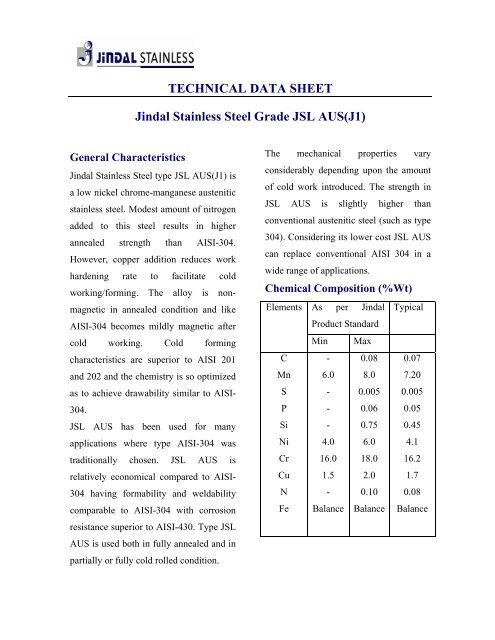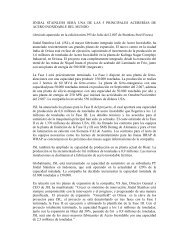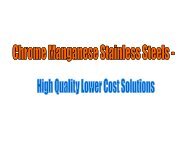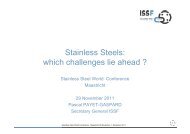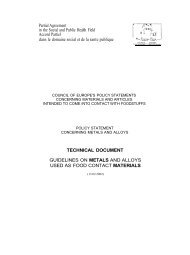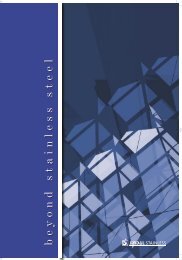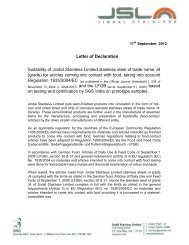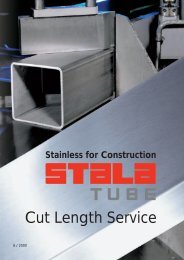Technical data of JSL Aus grades - Gual Steel
Technical data of JSL Aus grades - Gual Steel
Technical data of JSL Aus grades - Gual Steel
Create successful ePaper yourself
Turn your PDF publications into a flip-book with our unique Google optimized e-Paper software.
TECHNICAL DATA SHEET<br />
Jindal Stainless <strong>Steel</strong> Grade <strong>JSL</strong> AUS(J1)<br />
General Characteristics<br />
Jindal Stainless <strong>Steel</strong> type <strong>JSL</strong> AUS(J1) is<br />
a low nickel chrome-manganese austenitic<br />
stainless steel. Modest amount <strong>of</strong> nitrogen<br />
added to this steel results in higher<br />
annealed strength than AISI-304.<br />
However, copper addition reduces work<br />
hardening rate to facilitate cold<br />
working/forming. The alloy is nonmagnetic<br />
in annealed condition and like<br />
AISI-304 becomes mildly magnetic after<br />
cold working. Cold forming<br />
characteristics are superior to AISI 201<br />
and 202 and the chemistry is so optimized<br />
as to achieve drawability similar to AISI-<br />
304.<br />
<strong>JSL</strong> AUS has been used for many<br />
applications where type AISI-304 was<br />
traditionally chosen. <strong>JSL</strong> AUS is<br />
relatively economical compared to AISI-<br />
304 having formability and weldability<br />
comparable to AISI-304 with corrosion<br />
resistance superior to AISI-430. Type <strong>JSL</strong><br />
AUS is used both in fully annealed and in<br />
partially or fully cold rolled condition.<br />
The mechanical properties vary<br />
considerably depending upon the amount<br />
<strong>of</strong> cold work introduced. The strength in<br />
<strong>JSL</strong> AUS is slightly higher than<br />
conventional austenitic steel (such as type<br />
304). Considering its lower cost <strong>JSL</strong> AUS<br />
can replace conventional AISI 304 in a<br />
wide range <strong>of</strong> applications.<br />
Chemical Composition (%Wt)<br />
Elements As per Jindal Typical<br />
Product Standard<br />
Min Max<br />
C<br />
Mn<br />
S<br />
P<br />
Si<br />
Ni<br />
Cr<br />
Cu<br />
N<br />
Fe<br />
-<br />
6.0<br />
-<br />
-<br />
-<br />
4.0<br />
16.0<br />
1.5<br />
-<br />
Balance<br />
0.08<br />
8.0<br />
0.005<br />
0.06<br />
0.75<br />
6.0<br />
18.0<br />
2.0<br />
0.10<br />
Balance<br />
0.07<br />
7.20<br />
0.005<br />
0.05<br />
0.45<br />
4.1<br />
16.2<br />
1.7<br />
0.08<br />
Balance
Mechanical Properties<br />
UTS (MPa)<br />
YS (MPa)<br />
% Elongation<br />
Hardness<br />
(HRB)<br />
Ericcson<br />
Cupping Value<br />
Type<br />
<strong>JSL</strong> AUS<br />
550 min.<br />
205 min<br />
40 min.<br />
95 max.<br />
12-14<br />
Type 304<br />
515 min.<br />
205 min.<br />
40 min.<br />
92 max.<br />
12-13.5<br />
Test as per<br />
ASTM A262<br />
Practice B<br />
(Boiling Ferric<br />
Sulfate<br />
50% Sulphuric<br />
Acid)<br />
Practice C<br />
(65% Nitric Acid,<br />
Boiling)<br />
Corrosion Rate<br />
(mmpy)<br />
<strong>JSL</strong> Type<br />
AUS 304<br />
2.46 1.05<br />
0.93 0.32<br />
Typical Values<br />
UTS (MPa)<br />
YS<br />
(0.2%)(MPa)<br />
% Elongation<br />
Hardness(HRB)<br />
Ericcson<br />
Cupping Value<br />
665<br />
310<br />
55<br />
87<br />
12.9<br />
560<br />
262<br />
55<br />
83<br />
13.1<br />
Practice E<br />
(Copper/16%<br />
Copper<br />
Sulfate/Sulfuric<br />
Acid, Boiling)<br />
Practice A<br />
(Oxalic Acid etch<br />
Test)<br />
No<br />
cracks<br />
Step<br />
Structure<br />
No<br />
cracks<br />
Step<br />
Structure<br />
Corrosion Properties<br />
Intergranular Corrosion<br />
General atmospheric corrosion <strong>of</strong><br />
<strong>JSL</strong>-AUS in non-coastal atmosphere is<br />
comparable with Type 304. In<br />
intergranular corrosion test as per<br />
ASTM 262, <strong>JSL</strong> AUS and Type 304<br />
behave similarly in practice A and<br />
practice E tests. However, in boiling ferric<br />
sulphate and nitric acid, <strong>JSL</strong> AUS exhibits<br />
slightly inferior performance to Type 304.<br />
Corrosion in various food<br />
application media<br />
A series <strong>of</strong> corrosion tests in salt and<br />
organic acids, generally encountered in<br />
food processing and food packaging<br />
industries, clearly indicates that <strong>JSL</strong> AUS<br />
is a good cost effective substitute to Type<br />
304 in many applications. Acetic acid is<br />
present in vinegar. When milk<br />
deteriorates, lactic acid is produced. Citric<br />
acid is commonly present in fruit juices<br />
and tartaric acid is an ingredient in
tamarind extracts commonly used in<br />
Indian households. <strong>JSL</strong> AUS has been<br />
tested in individual acids and in<br />
combination with varying concentration to<br />
asses its corrosion resistance properties.<br />
The salt spray test in 5% NaCl<br />
environment shows <strong>JSL</strong> AUS has similar<br />
or even better resistance to common salt<br />
in comparison with Type 304.<br />
Test media<br />
3% NaCl for 720<br />
hrs<br />
at RT(25 o C)<br />
3% NaCl for 100<br />
hrs<br />
at Boiling Temp.<br />
(0.5%Citric+0.5<br />
%Tartaric)<br />
for 720 hrs at RT<br />
(0.5%Citric+0.5<br />
%Tartaric)<br />
for 100 hrs<br />
boiling<br />
(0.5%Acetic<br />
+0.5%Lactic) for<br />
720 hrs at RT<br />
(0.5%Acetic<br />
+0.5%Lactic) for<br />
120 hrs at<br />
Boiling Temp.<br />
Corr rate<br />
(mmpy)<br />
<strong>JSL</strong> AUS<br />
Corr rate<br />
(mmpy)<br />
304<br />
0.0004 0.00132<br />
0.0114834 0.001066<br />
0.0005525 0.0000034<br />
0.006721 0.000018<br />
0.0018 0.00051<br />
0.0101 0.001669<br />
Note: The corrosion rate less than<br />
0.02mm per year (mmpy) is considered<br />
excellent (Ref: Mars. G. Fontanna,<br />
Corrosion Engineering, Table 4-5, P 172)<br />
Salt Spray Test<br />
5% NaCl environment (for 120 hrs)<br />
Grade Corrosion rate (mmpy)<br />
<strong>JSL</strong> AUS 0.0003729<br />
304 0.00044<br />
Heat Treatment<br />
Type <strong>JSL</strong> AUS is annealed between<br />
1050–1100 o C. The annealing temperature<br />
should not exceed 1100 o C to avoid<br />
excessive oxidation and grain coarsening.<br />
The primary purpose <strong>of</strong> annealing is to<br />
relieve strain, recrystallize the material if<br />
it has been cold worked and to take<br />
carbides into solution. For <strong>JSL</strong> AUS,<br />
rapid cooling through the carbide<br />
precipitation range (500–800 o C) is<br />
necessary to avoid the precipitation <strong>of</strong><br />
carbides at grain-boundaries.<br />
Fabrication<br />
Welding<br />
Type <strong>JSL</strong> AUS can be welded by all<br />
conventional methods applied to 18/8<br />
type <strong>of</strong> austenitic stainless steel. Filler<br />
wires or electrodes <strong>of</strong> the conventional<br />
chromium-nickel 300 series can be used.<br />
Its susceptibility to intergranular<br />
corrosion in weld heat-affected zone is<br />
analogous to AISI 304.<br />
Hot Working<br />
<strong>JSL</strong> AUS can be readily rolled or forged,<br />
and required similar power for a given<br />
reduction as in case <strong>of</strong> AISI 304 stainless<br />
steel.
Cold Working<br />
<strong>JSL</strong> AUS is very tough and ductile and<br />
readily amenable to deep drawing,<br />
bending, stretch forming and spinning.<br />
After heavy cold working, it is only<br />
mildly magnetic like 304.<br />
Typical Applications<br />
Catering & Food Processing<br />
Deep drawn utensils, Pressure cookers,<br />
Water filters, Storage vessels, Milk cans.<br />
Consumer Durables<br />
Spin driers <strong>of</strong> Washing machine,<br />
Microwave ovens, Decorative trim, Dish<br />
washers, Thermo ware.<br />
Architecture, Building & Construction<br />
Doors and window frames, Column<br />
claddings, Furniture, Bus shelters,<br />
Telephone booths, Pipes and Tubes, Hand<br />
rails, Ornamental tubes, Tree guards, and<br />
Kitchen sinks.<br />
Transport (Automotive)<br />
Automotive trim, Wheel caps, Wiper<br />
arms, Rims, Auto accessories.<br />
Industry<br />
Beer, Wine, Beverage, Dairy equipment,<br />
Food processing and packing equipment<br />
Product and Surface Finish *<br />
Product<br />
Size (mm)<br />
Surface<br />
Process<br />
Edge Condition<br />
t x w x l<br />
Quality<br />
HR Coil<br />
2.8-6.0 X 1050<br />
Black<br />
HR<br />
Mill<br />
No.1<br />
HRAP<br />
Trim / Mill<br />
HR Plate and<br />
4.0-50.0 X 1250 max X<br />
No.1<br />
HRAP<br />
Trim / Mill<br />
Sheet<br />
7000 max<br />
2D<br />
CRAP<br />
Trim / Mill<br />
CR Coil and<br />
0.4-4.0 X 1250 max<br />
2B<br />
CRAP+SP<br />
Trim / Mill<br />
Sheets<br />
No.3<br />
CRAP+SP+G<br />
Trim / Mill<br />
No.4<br />
CRAP+SP+G<br />
Trim / Mill<br />
* For details, refer to <strong>Technical</strong> Brochure <strong>of</strong> Jindal Stainless.<br />
HR- Hot Rolled, CR- Cold Rolled, HRAP- Hot Rolled Annealed and Pickled,<br />
CRAP-Cold Rolled Annealed and Pickled, SP- Skin Pass, G- Ground.
Notice:<br />
• Information in this document is<br />
only for the explanation <strong>of</strong> general<br />
characteristics and properties <strong>of</strong><br />
<strong>JSL</strong> products, not for the guarantee<br />
for the material.<br />
• <strong>Technical</strong> information in this<br />
document is subject to change by<br />
environment condition and the<br />
purpose <strong>of</strong> use.<br />
Contact for information:<br />
Marketing Division,<br />
Corporate Office,<br />
Jindal Center,<br />
12-Bhikaiji Cama Place,<br />
New Delhi- 110066<br />
Tel- +91(011)26188340-50<br />
Fax- 91(011)26161271<br />
E mail: info@jindalsteel.com


